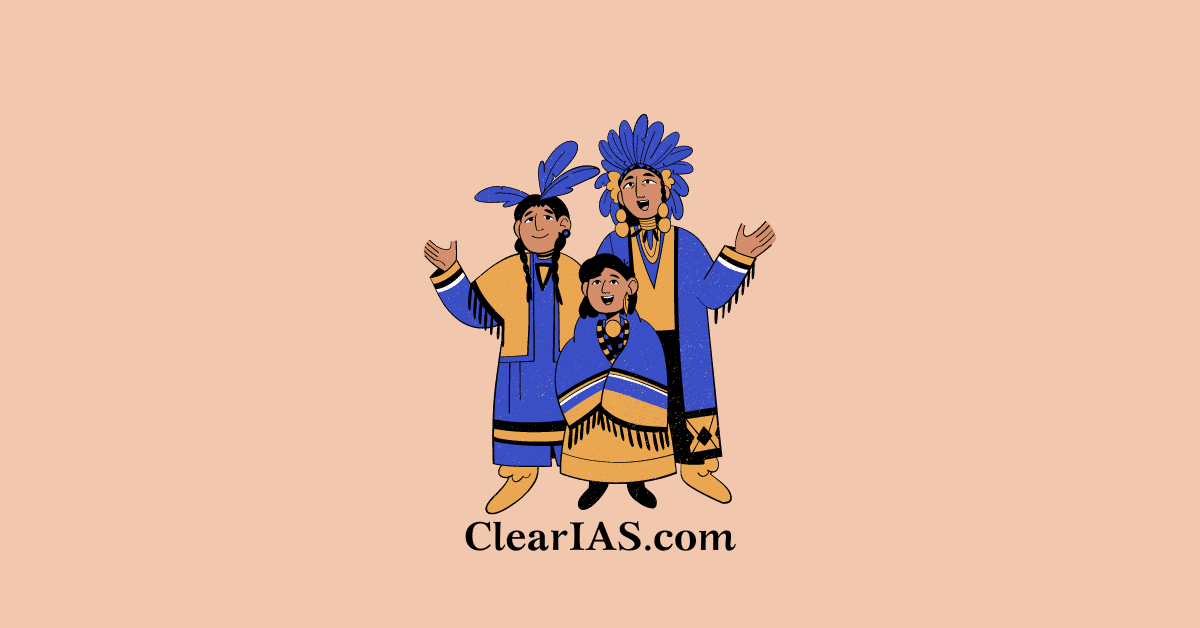 The government of India has launched 3 new initiatives for the holistic development of Particularly Vulnerable Tribal Groups (PVTGs). Read here to learn about PVTGs, the challenges faced by them, key government initiatives related to PVTGs, etc.
The government of India has launched 3 new initiatives for the holistic development of Particularly Vulnerable Tribal Groups (PVTGs). Read here to learn about PVTGs, the challenges faced by them, key government initiatives related to PVTGs, etc.
Particularly Vulnerable Tribal Groups (PVTGs) are tribal communities in India. These are those tribal groups that face greater hardships and are more at risk than others.
They are characterized by declining or stagnant populations, low levels of literacy, pre-agricultural levels of technology, and economic backwardness.
The central government has recognized 75 tribal communities as PVTGs spread across 18 states and union territories.
History of Particularly Vulnerable Tribal Groups (PVTGs)
In 1973, the Dhebar Commission categorized the most vulnerable and marginalized tribal communities as ‘Primitive Tribal Groups’ (PTGs).
This was done to identify tribal groups that were at a lower level of social and economic development compared to other tribal communities.
In 2006, the Government of India renamed PTGs as ‘Particularly Vulnerable Tribal Groups’ (PVTGs).
The distinguishing characteristics of PVTGs include – a stagnant or declining population, low literacy levels, pre-agricultural level of technology, and economic and social backwardness.
Based on these criteria, in 1975 the government identified 52 PVTGs. In 1993, an additional 23 groups were added, taking the total number of identified PVTGs to 75.
The highest number of PVTGs are found in Odisha (13), followed by Andhra Pradesh (12), Gujarat (8) and Tamil Nadu (6), while no PVTGs are found in the states of Punjab and Haryana.
The PVTG of Sahariyas has the highest population of 4,50,217, while the PVTGs of Sentinelets and Andamanese have a very small population, respectively.
Criteria to Identify Particularly Vulnerable Tribal Groups
The identification of such groups was based on one or more of the following characteristics:
- Preservation of pre-agricultural practices,
- Economic Backwardness,
- Decreasing or stagnant population growth, and
- Relatively low levels of literacy in contrast to other tribal groups.
Challenges faced by PVTGs
Despite efforts by the government, PVTGs continue to face immense challenges that have kept them vulnerable and marginalized.
Declining population: Many PVTGs are experiencing stagnant or declining population. This is due to high mortality rates aggravated by malnutrition, poor access to healthcare, and diseases.
Loss of traditional livelihoods: PVTGs traditionally relied on forest produce, food gathering, and shifting agriculture. Depletion of forests and restrictive forest laws have eroded their traditional livelihoods and food security.
Land alienation: Historically, PVTGs enjoyed rights over forestlands under various traditional and customary tenurial systems. The process of declaring forests as Protected Areas and Reserves has displaced and alienated PVTGs from their traditional landholdings.
Poor literacy: PVTGs suffer from extremely low literacy levels due to a lack of access to education facilities like schools, transportation, teacher absence, etc. This hampers their participation in development.
Geographical isolation: PVTG settlements are often small and located in remote, hilly, or densely forested areas with poor connectivity. This heightens their exclusion.
Impact of development projects: Development projects like mining, dams, industries, etc undertaken on tribal lands without proper rehabilitation have led to the displacement of PVTGs.
Socio-economic backwardness: PVTGs lag behind other social groups on parameters like poverty, malnutrition, mortality rates etc due to historical neglect and exclusion.
Important Tribal Welfare Initiatives
On the Janjatiya Gaurav Divas (15 November), PM Modi unveiled three significant schemes for uplifting Particularly Vulnerable Tribal Groups (PVTGs) –
PM Janjati Adivasi Nyaya Maha Abhiyan (PM JANMAN)
Key information related to the scheme are:
- PM JANMAN is a Rs 24,104 crore tribal welfare program that will extend socio-economic justice and inclusion to over 40 lakh people from 75 PVTGs.
- PVTGs are marginalized tribal groups identified based on characteristics like declining population, low literacy levels, and economic backwardness.
- Under PM JANMAN, PVTG families will be provided with land rights, housing, education, healthcare, drinking water, livelihoods, roads, and other basic amenities.
- It aims to plug the gaps these vulnerable groups face in accessing welfare schemes and public services. PM JANMAN will be implemented over 3 years till 2023-26.
Viksit Bharat Sankalp Yatra
Important features of this Yatra are:
- This mega outreach initiative will raise awareness about central government welfare programs among PVTG communities.
- Through camps across districts with significant PVTG populations, the yatra will identify beneficiaries and enroll them into various schemes.
- Welfare measures under focus include financial services, LPG connections, electricity, housing, sanitation facilities, nutrition, and healthcare among others.
- The Yatra will also gather feedback from PVTG families to understand gaps in service delivery and ensure last-mile connectivity.
PM PVTG Development Mission
Key features of PM PVTG Development Mission are:
- This mission aims to comprehensively improve the socio-economic status of PVTGs in line with the 15-year vision of the Panchayati Raj Ministry.
- It will ensure the provision of basic amenities such as pucca housing, drinking water supply, functional toilets, connectivity, healthcare, nutrition, and education in PVTG areas.
- Livelihood opportunities will be enhanced via animal husbandry, horticulture, and skill development. Conservation of PVTG culture and heritage is also envisaged.
- The Union Budget 2022-23 has allocated Rs 24,000 crore for tribal welfare. Of this, a significant share will be utilized under the PM PVTG Development Mission.
Significance of the Initiatives
The significance of these initiatives are:
- Holistic development: These initiatives cover all aspects of socio-economic progress – livelihoods, health, education, and culture.
- Rights-based: Secure land rights, forest rights, and housing rights for PVTGs can protect them against displacement.
- Access to services: Seamless access to welfare schemes, public services, and infrastructure development will be enabled.
- Financial inclusion: Enhanced livelihood opportunities and financial literacy can bring PVTGs into the formal banking system.
- Culture preservation: Conservation of PVTG heritage, art, and language can safeguard their identity.
- Bottom-up approach: Feedback-based planning and localization of schemes based on the needs of specific PVTGs.
The Way Forward
While government initiatives and budgets for PVTG development have increased, effective implementation on the ground holds the key. PVTGs need to be actively involved in the planning and execution of schemes meant for them.
Protecting their traditional rights over jal-jameen-jangal is very important.
Overall, adopting a rights-based approach, ensuring social security and accountability can help PVTGs break out of the cycle of vulnerability.
Related Articles:
Article Written By: Priti Raj






Leave a Reply